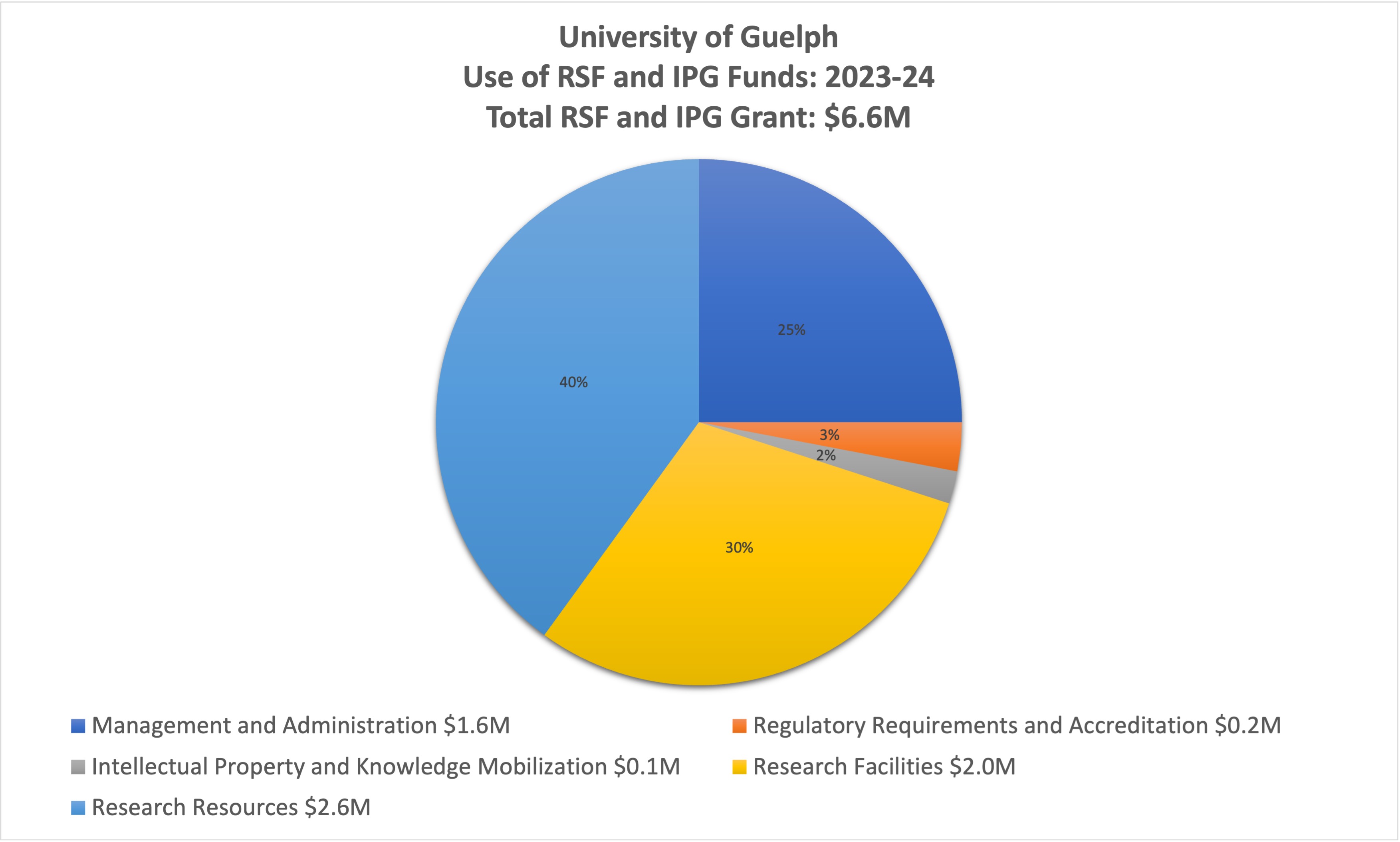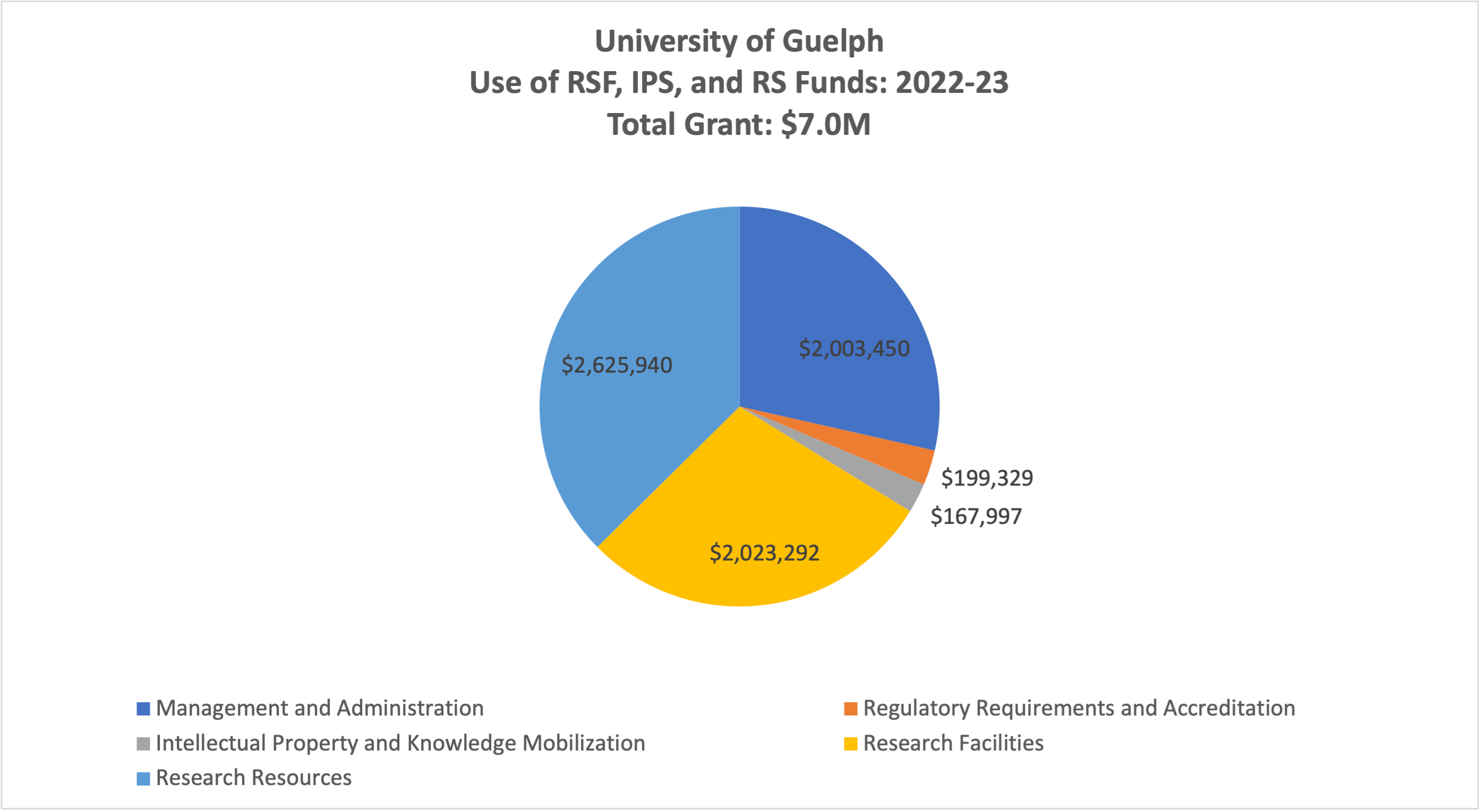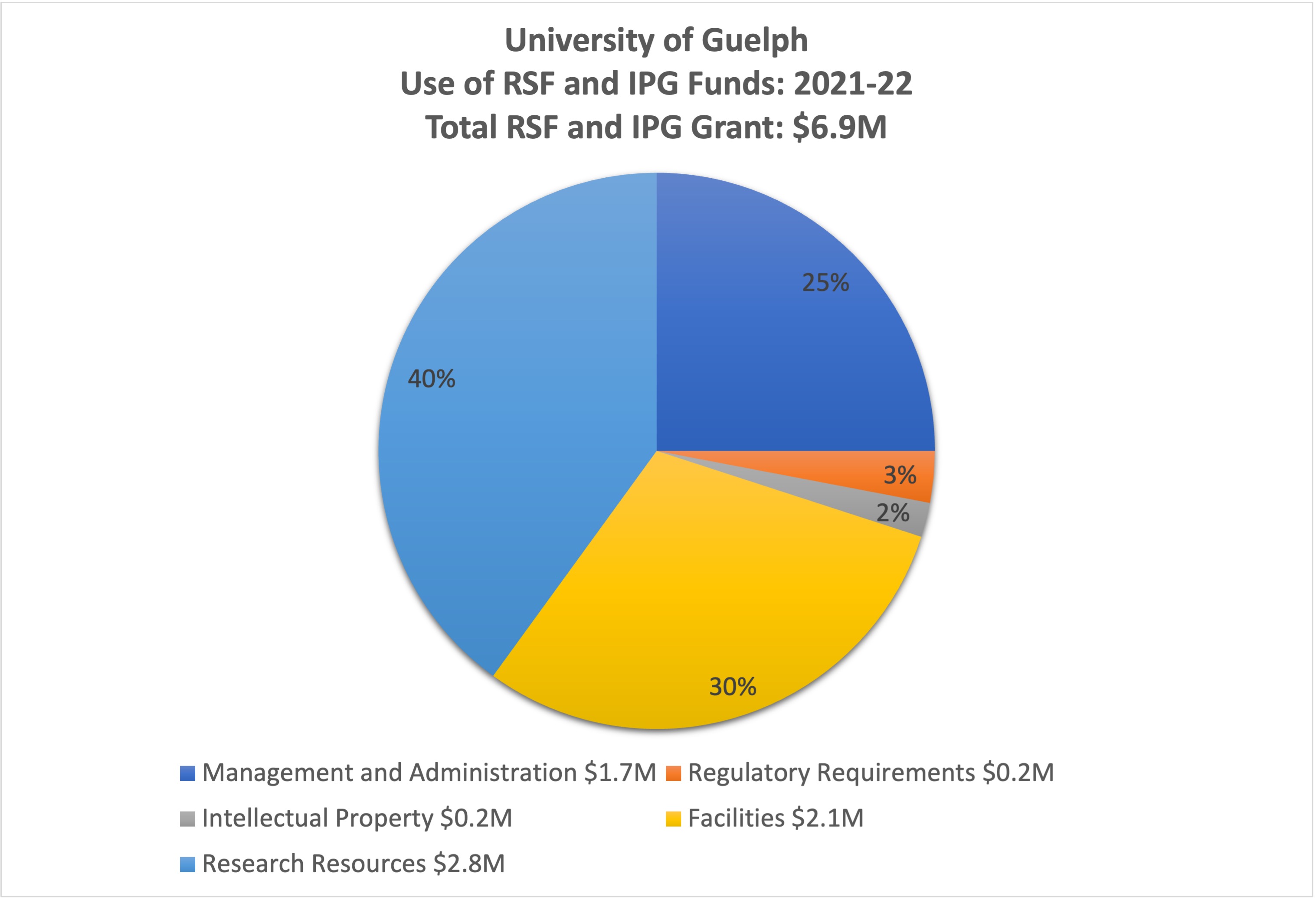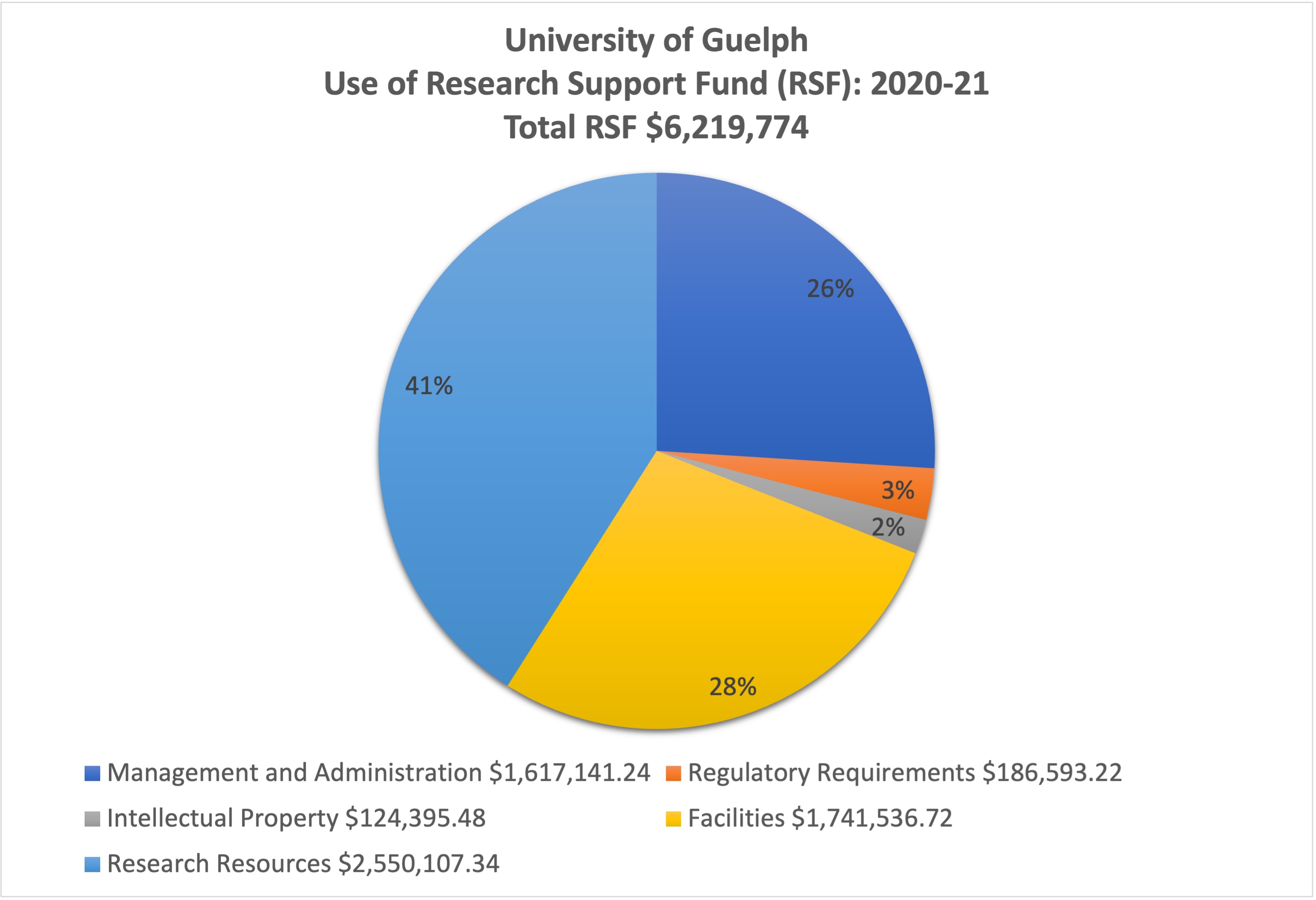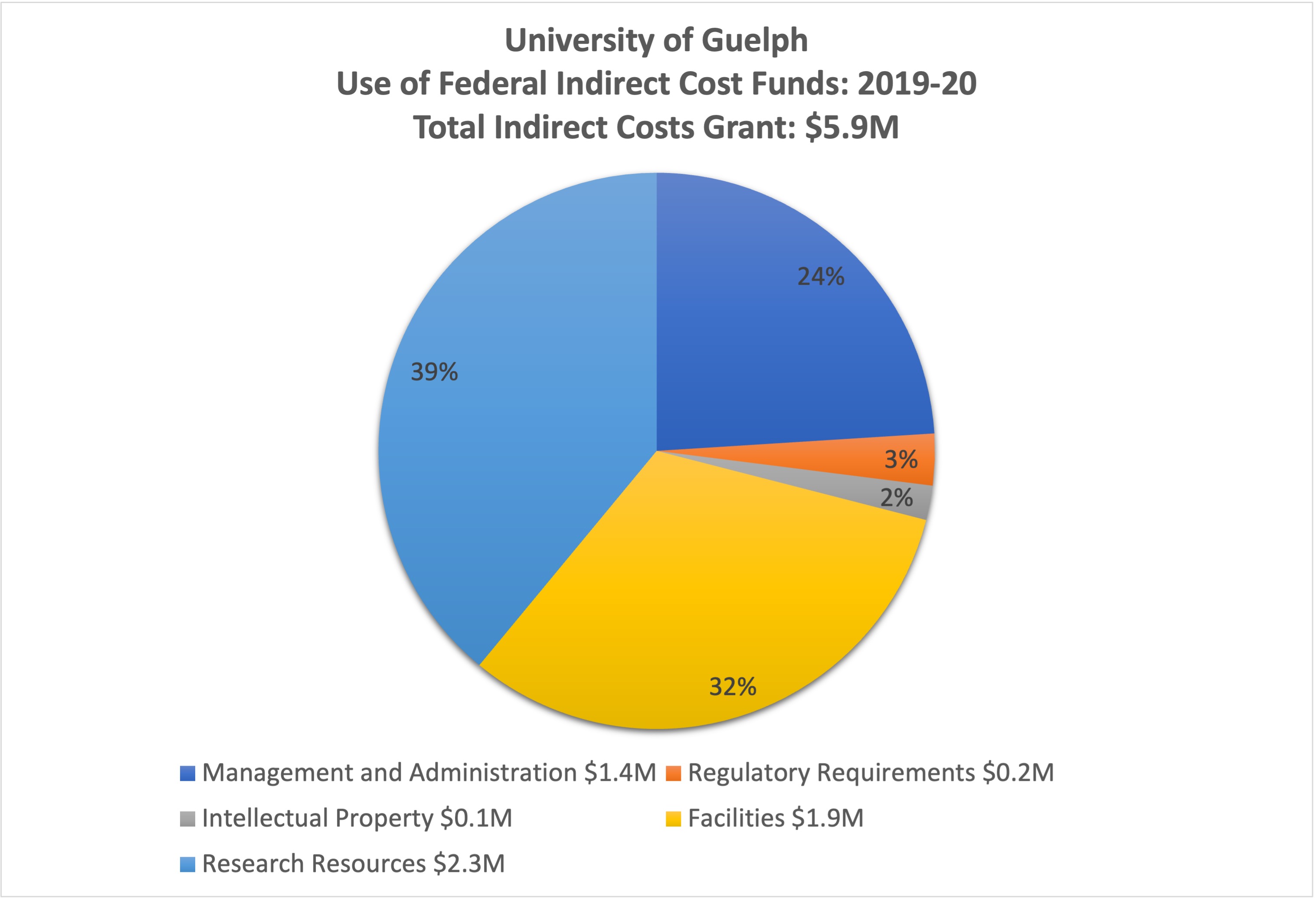The Research Support Fund assists Canadian postsecondary institutions with the costs associated with managing their research enterprise, helping them to maintain a world-class research environment. Grants are intended to make Canada a world leader in research and development:
- maintain modern labs and equipment;
- provide access to up-to-date knowledge resources;
- provide research management and administrative support;
- meet regulatory and ethical standards; or
- transfer knowledge from academia to the private, public, and not-for-profit sectors.
Definition of Indirect Costs
There are a number of centralized institutional activities and services that support the research mandate of the University. These vary in scope and size but are critical to our success.
Institutional activities and support services include the following areas:
- Library: operations and information acquisitions and resources
- Computing and Communications: computing infrastructure including central services, telecommunications, and data services
- Physical Plant: utilities, housekeeping, maintenance, grounds, and planning services (excluding ancillary operations)
- Research Administration: Research Services Office including central animal services, grants and contracts administration and legislated requirements for reporting on grants and activities, communications, and business development
- Central Support Services: a wide range of services ranging from payroll, accounting including research accounting, audit, environmental and occupational health, security services and purchasing to institutional costs such as legal and insurance costs
Each of these activities is vital to the overall effectiveness of the institution. Coordinating and delivering these services is a complex task and there are significant efficiencies to be obtained by managing them centrally.
Overview how University of Guelph Allocates the Research Support Funds grant
In general, the allocation of the RSF grant to specific units that support research activity at the University is calculated as:
| RSF Allocation | = | (Total Unit Costs * Percentage of Research * Percentage of Federal * RSF Grant ) |
| RSF Eligible Costs |
Units incurring indirect costs of research are identified within the broad categories outlined as eligible by the RSF program. The specific units, by category, are as follows:
- Research Facilities (Utilities, Physical Resources, Waste and Chemical Resources, Advanced Analysis Centre)
- Research Resources (Library Operations, Library Information Resources, Central Computing Systems)
- Management and Administration of the Institution’s Research Enterprise (Office of Research, Research Financial Services, Administrative Offices, Insurance, Research Administration Information Management System)
- Regulatory Requirements and Accreditation (VP Research-General Risk, Animal Care Services, Environmental Health & Safety)
- Intellectual Property and Knowledge Mobilization (Research Innovation Office)
It is then determined what portion of the unit costs are used to support research activities, using various assumptions depending on the specific unit.
The total research costs determined above are prorated to reflect the portion of research that is federally funded using a three-year average of total funding received from NSERC, SSHRC, CIHR and Networks of Centres of Excellences, as reported to the University in the RSF credit data, divided over total received from external sponsors (excluding RSF & CFI). This represents total costs eligible for RSF funding.
The actual amount of the RSF grant that the University receives does not cover the total amount of eligible costs, so the grant is attributed on a pro rata basis to the eligible costs of each of the units.
Use of Funds
RSF Institutional Performance Objectives and Indicators
| Eligible Expenditure Category | Output | Institutional Performance Objective(s) | Performance Indicator(s) |
|---|---|---|---|
| Research Facilities | Invest a portion of Research Support Fund grant in operations, upgrades, and maintenance of the University’s Advanced Analysis Centre (AAC). | To increase the use of centralized research scientific equipment through the AAC by offering cost- effective and efficient testing and experimental support services to researchers across campus. |
Continuous improvement in both volume of services processed, relevance of services provided and response times for research services across all AAC research service facilities. Increase usage by researchers across campus (students, staff, faculty). Continued investment in new infrastructure. |
| Research Resources | Invest portion of Research Support Fund grant to support new research data management (RDM) process (staff and IT resources). |
To increase the volume of collection and improve the access to research data through a centralized research management data information system. Increase the number of Data Management Plans (DMP) created by researchers. Increase the use of the Canada-wide tool DMP Assistant to create plans. |
Increase in total number of data sets and associated code books captured in the RDM system each fiscal year. Increase number of registered researchers and associated data management plans in the DMP Assistant system each fiscal year. |
| Management and Administration of the Institution’s Research Enterprise | Invest portion of Research Support Fund grant to support e-system development for the integrated administration of animal ethics, human ethics, biosafety and grants and contracts. | Identify system requirements and complete Request for Proposal (RFP), procurement, and implementation processes. | Continued automation and process improvement of research administrative processes for staff and reporting to stakeholders. |
| Regulatory requirement and Accreditation | Invest portion of Research Support Fund grant towards salary support of personnel within Animal Care Services for Post Approval monitoring. | Continued implementation of the Post-Approval Review (PAR) program in support of PIs and their research teams when conducting research involving animals. | Continue to implement the full PAR program focusing on direct support to researchers and their team by involving PAR in the review of all AUP annual renewals, developing refinement in animal user, and offering PAR services with species and procedure expertise that will also add to PAR’s goal of encouraging and modelling best practices in animal-based research. |
| Intellectual Property and Knowledge Mobilization | Invest portion of Research Support Fund grant to support faculty disclosures including communication, training, and support services to faculty. | To be one of Canada’s most inventive universities. | Number of inventions per research dollar in comparison to other institutions in Canada. |
RSF Progress Reports
| Eligible Expenditure Category | Target Outcomes for 2023/24 | Reported Outcomes 2023/24 | Target Outcomes 2024/25 |
|---|---|---|---|
| Research Facilities |
The AAC (Advanced Analysis Centre) expects to realize a 5% annual increase in total user fee income. Increase awareness and thus usage of core (centralized) research facilities is expected through our affiliation with the Office of Research, our updated website and various campus events to promote the list of services provided. |
While internal user fee income decreased by 11% in 2023-24, external user fee income was up 57% from the previous fiscal year. New equipment acquisitions were secured for modern equipment to be installed in the Mass Spectrometry Facility, Advanced Light Microscopy and the Genomics Facility. The AAC keeps research initiatives at the forefront and raises awareness in its operations through the organization of regular seminars. For instance, the Molecular and Cellular Imaging Facility organized demonstration events with 4 different vendors in 2023-24. These events engaged faculty and graduate students in new technologies and exhibited how these new approaches could advance their research. The AAC is widely used by faculty and their trainees: Over 150 faculty used one or more of the five labs. |
The AAC (Advanced Analysis Centre) expects to realize a 5% annual increase in total user fee income. Increase awareness and thus usage of core (centralized) research facilities is expected through our affiliation with the Office of Research, our updated website and various campus events to promote the list of services provided. |
| Research Resources |
Data deposits:
Usage statistics:
Research data management / planning:
|
Data deposits:
Usage statistics:
Data management planning:
|
Data deposits:
Usage statistics:
Research data management / planning:
|
| Management and Administration of the Institution’s Research Enterprise |
Complete Request for Proposal (RFP) process for an animal care research administration solution as the second module in a fully integrated research administration system. Implement human ethics research administration solution in a production environment by the end of Q4 2023/24. |
Completed recruitment processes to hire three new staff members to support implementation of the human ethics solution (i.e., project manager, change manager and processes/systems manager); worked to configure the solution to implement revised workflow processes; developed forms for human ethics administration within the system, initiation and consultation with research community to ensure robustness and accuracy of forms, etc. System go-live planned for summer 2024. |
Complete Request for Proposal (RFP) process for an animal care research administration solution as the second module in a fully integrated research administration system. Implement human ethics research administration solution in a production environment in summer 2024, including migration of legacy protocols. |
| Regulatory Requirement and Accreditation | Continue the Post-Approval Review (PAR) program focusing on direct support to PIs and their research teams by focusing on the collaborative work between researchers, veterinarians, animal care staff, animal facility management, dedicated PAR staff, and the Animal Care Committee. | The PAR program was strengthened by the appointment of a new ACS veterinarian (continuing full-time, April 2024) with focus on post-approval support and services to investigators and their research teams in the conduct of approved studies, especially in health and welfare related matters. | Continue the Post-Approval Review (PAR) program as the quality assurance for conducting and progressing research projects involving live animals. Emphasis is placed on providing support and services to the investigators and research team members in all aspects of their live animal use. |
| Intellectual Property and Knowledge Mobilization | Number of inventions per research dollar in comparison to other institutions in Canada. | U of G reported 126 inventions, and a 3-year average of 139. The 3-year average results in approximately 1 invention per $1.3M of research, which places UG among the top universities in the country according to that metric. | Number of inventions per research dollar in comparison to other institutions in Canada. |
| Eligible Expenditure Category | Target Outcomes for 2022/23 | Reported Outcomes 2022/23 | Target Outcomes 2023/24 |
|---|---|---|---|
| Research Facilities |
The AAC expects to realize a 5% annual increase in total user fee income. Increase awareness and thus usage of core (centralized) research facilities. |
Internal user fee income met and exceeded the target user fee income predicted for 2022-23. Usage remained strong in both the Genomics and Imaging Facilities. Increased services in the Mass Spectrometry Facility also contributed to the doubling of the annual increase predicted. The total number of faculty members using the AAC increased only modestly from 2021-22. Faculty usage of AAC facilities is consistent and they are utilizing more services than in the previous year. User fee income from external sources increased by 18.5% from 2021-22. This source of income is unpredictable as it depends on global factors beyond our control. |
Realize a 5% annual increase in total user fee income. Increase awareness and thus usage of core (centralized) research facilities is expected through our affiliation with the Office of Research, our updated website and various campus events to promote the list of services provided. |
| Research Resources |
Data deposits:
Usage statistics:
Research data management / planning:
|
Data deposits:
Usage statistics:
Data management planning:
|
Data deposits:
Usage statistics:
Research data management / planning:
|
| Management and Administration of the Institution’s Research Enterprise |
Complete Request for Proposal (RFP) process for a human ethics research administration solution as a first module in a fully integrated research administration system. Implement human ethics research administration solution in a production environment by the end of Q4 2022/23. |
The RFP process for a human ethics research administration solution was completed; the procurement process took place to select the most suitable vendor; and the contract was signed. |
Complete Request for Proposal (RFP) process for an animal care research administration solution as the second module in a fully integrated research administration system. Implement human ethics research administration solution in a production environment by the end of Q4 2023/24. |
| Regulatory Requirement and Accreditation | Continue the Post-Approval Review (PAR) program focusing on direct support to PIs and their research teams by focusing on the collaborative work between researchers, veterinarians, animal care staff, animal facility management, dedicated PAR staff, and the Animal Care Committee. |
The PAR program was re-instated in its full capacity after lifted COVID-19 restrictions. Regular PAR visits have been conducted in animal facilities at Guelph Campus, at the agricultural and aquatic research stations, and on the regional campuses Ridgetown and New Liskeard. The PAR visits were ‘Proactive’ - scheduled meetings with investigators, and research team members, and ‘Reactive’ - on-site visits occurring following animal incidents, regulatory requirements, or decisions from the Animal Care Committee. The PAR program also introduced monthly written reports to the Animal Care Committee for visits with the PAR Coordinator. |
Continue regular PAR will continue as the quality assurance for conducting and progressing research projects involving live animals. |
| Intellectual Property and Knowledge Mobilization | Number of inventions per research dollar in comparison to other institutions in Canada. | U of G reported 215 inventions, and a 3-year average of 159. The 3-year average results in approximately 1 invention per $1.1M of research, which places UG among the top universities in the country according to that metric. | Number of inventions per research dollar in comparison to other institutions in Canada. |
-
RSF Progress Report 2021-22

-
RSF Progress Report 2020-21

-
RSF Progress Report 2019-20

-
RSF Progress Report 2018-19

Institutional Project Grants (IPG) Stream: Advanced Analysis Centre
The IPG is used to support the strategic mission and objectives of the Advanced Analysis Centre (AAC), the University of Guelph's (U of G) core institutional facility that provides the infrastructure and technical expertise to support advanced analytical technologies to foster research and education at the interface of the physical and biological sciences. The AAC is a group of research laboratories housed in the University’s Summerlee Science Complex. The AAC spans an area of over 1000 m2 and currently contains over $37M of research equipment purchased with funds from the Canada Foundation for Innovation, the Ontario Research Fund, NSERC and internal investments. The AAC provides modern, centralized, and highly serviced space for large-scale advanced analytical laboratories including state-of-the-art Nuclear Magnetic Resonance, Mass Spectrometry, Electron Microscopy, Advanced Light Microscopy, Genomics, and a plant growth facility (Phytotron). The mission of the AAC is to provide researchers access to modern research services, analyses, instruments and technology, technical expertise, and expert training and education that are generally too expensive, complex, or specialized for researchers to cost-effectively acquire and sustain themselves. The IPG supports AAC technical staff salaries, operations, and maintenance of the technical equipment in accordance with its mission. The IPG supports the AAC in the following priority area: Facilities renewal, including deferred maintenance.
IPG Performance Objectives and Indicators
| IPG Priority Area | Output | Institutional Performance Objective(s) | Performance Indicator(s) |
|---|---|---|---|
| Facilities Renewal | Invest a portion of Research Support Fund grant in operations, upgrades, and maintenance of the University’s Advanced Analysis Centre (AAC). | To increase the use of centralized research scientific equipment through the AAC by offering cost- effective and efficient testing and experimental support services to researchers across campus. |
Continuous improvement in both volume of services processed, relevance of services provided and response times for research services across all AAC research service facilities. Increase usage by researchers across campus (students, staff, faculty). Continued investment in new infrastructure. |
IPG Progress Report
| IPG Priority Area | Target Outcome for 2023/24 | Reported Outcome 2023/24 | Target Outcome 2024/25 |
|---|---|---|---|
|
Facilities Renewal $742,870.00 invested in AAC |
The AAC (Advanced Analysis Centre) expects to realize a 5% annual increase in total user fee income. Increase awareness and thus usage of core (centralized) research facilities is expected through our affiliation with the Office of Research, our updated website and various campus events to promote the list of services provided. |
While internal user fee income decreased by 11% in 2023-24, external user fee income was up 57% from the previous fiscal year. New equipment acquisitions were secured for modern equipment to be installed in the Mass Spectrometry Facility, Advanced Light Microscopy and the Genomics Facility. The AAC keeps research initiatives at the forefront and raises awareness in its operations through the organization of regular seminars. For instance, the Molecular and Cellular Imaging Facility organized demonstration events with 4 different vendors in 2023-24. These events engaged faculty and graduate students in new technologies and exhibited how these new approaches could advance their research. The AAC is widely used by faculty and their trainees: Over 150 faculty used one or more of the five labs. |
The AAC expects to realize a 5% annual increase in total user fee income. Increase awareness and thus usage of core (centralized) research facilities is expected through our affiliation with the Office of Research, our updated website and various campus events to promote the list of services provided. |
| IPG Priority Area | Target Outcome for 2022/23 | Reported Outcome 2022/23 | Target Outcome 2023/24 |
|---|---|---|---|
|
Facilities Renewal Output: $750,513 invested in AAC |
The AAC expects to realize a 5% annual increase in total user fee income. Increase awareness and thus usage of core (centralized) research facilities. |
Internal user fee income met and exceeded the target user fee income predicted for 2022-23. Usage continued to remain strong in both the Genomics and Imaging Facilities. Increased services in the Mass Spectrometry Facility also contributed to the doubling of the annual increase predicted. The total number of faculty members using the AAC increased only modestly from 2021-22. Faculty usage of AAC facilities is consistent and they are spending more (utilizing more services) than in the previous year. User fee income from external sources increased by 18.5% from 2021-22. This source of income is unpredictable as it depends on global factors beyond our control. |
The AAC expects to realize a 5% annual increase in total user fee income. Increase awareness and thus usage of core (centralized) research facilities is expected through our affiliation with the Office of Research, our updated website and various campus events to promote the list of services provided. |
Research Security Stream: University of Guelph’s Research Security Program
University of Guelph (UofG) is committed to safeguarding research while maintaining the integrity of scientific collaborations. UofG continues to develop a research security program that advances security matters in research, internationalization, and commercialization, while safeguarding against theft of research data, loss of intellectual property (IP), unwanted access and potential interference, and transfer of knowledge in ways that researchers do not intend while upholding the core value of inclusive research excellence.
UofG’s program embraces Canada’s guiding principles for research security, including the principle on equity, diversity and inclusion that promotes “diversity of identity and thought, with room for a variety of ideas, cultures, and views while ensuring that everyone, regardless of background or identity, is able to freely participate in the research ecosystem to help build an innovative, prosperous, and inclusive world.” This aligns with the University’s commitment to indigenization, equity, diversity and inclusion.
UofG will further develop its policies, practices and resources to enhance research security practices that are adaptive to evolving threats, raise awareness, and equip researchers to protect their data, results, and IP.
UofG’s program is built on strong relationships with government, funding agencies and colleagues to ensure alignment with government mandates, agency policy requirements and best practices.
Research Security Performance Objectives and Indicators
| Output (investment of research security funds) | Performance Objective(s) | Performance Indicator(s) | Target Outcome |
|---|---|---|---|
| Human resources for research security including hiring for a position dedicated to research security ($265,000) | Further develop and coordinate the Research Security Program across the institution. |
Research security position has been recruited. Processes and resources developed and published to support risk assessment and mitigation. |
Human resources in place to coordinate research security across the institution. |
| Technology-based due diligence screening tool(s) ($55,000) | Develop consistent, reliable and efficient partner screening processes. | License/subscription for a commercial technology-based due diligence screening tool has been acquired. | Due diligence screening tool has been incorporated into the process for risk assessments of research partners. |
| Outreach, professional development education, and awareness ($15,500) | Increase awareness about research security related risk and project-based mitigation measures and institutional level practices. | Outreach, awareness, and education opportunities provided to the University research community. |
Research security has been incorporated into funding program workshops. Safeguarding science workshop has been provided (if available through Research Security Centre). U of G is a member of University peer groups related to Research Security (e.g., Team Canada) and participates in related events and activities. |
| Issues management ($12,500) | Support of arising unanticipated research security related concerns. | Arising concerns related to safeguarding research identified and reviewed on a case-by-case basis. | Concerns related to safeguarding research are addressed. |
Research Security Progress Reports
| Output (investment of research security funds) | Performance Objective(s) for 2023/24 | Performance Indicator(s) for 2023/24 | Target Outcome for 2024/25 | Reported Outcome for 2023/24 |
|---|---|---|---|---|
| Human resources for research security including hiring for a position dedicated to research security ($265,000) | Assist in coordinating research security across the institution. | Research security position has been recruited. | Human resources in place to coordinate research security across the institution. | Role dedicated to Research Security was filled. Institutional process to support NSGRP review and implementation of STRAC policy developed. |
| Technology-based due diligence screening tool(s) ($50,000) | Develop consistent, reliable and efficient partner screening processes. | License/subscription for a commercial technology-based due diligence screening tool has been acquired. | Due diligence screening tool has been incorporated into the process for risk assessments of research partners. | Due diligence screening tool has been incorporated into the process for risk assessments of research partners. |
| Outreach, professional development education, and awareness ($15,500) | Increase awareness about research security related risk and project-based mitigation measures and institutional level practices. |
Research security has been incorporated into funding program workshops. Safeguarding science workshop has been provided (if available through Research Security Centre).
U of G is a member of University peer groups related to Research Security and participates in peer group meetings and events. |
Research security has been incorporated into funding program workshops. Safeguarding science workshop has been provided (if available through Research Security Centre).
U of G is a member of University peer groups related to Research Security (e.g., Team Canada) and participates in related events and activities. |
Research security incorporated into funding program workshops as applicable, including those associated with CFI, and NSERC. On-site briefings conducted by DG Academic Outreach and Stakeholder Engagement Branch of CSIS. Research security outreach conducted across colleges. U of G is a member of University peer groups related to Research Security (e.g., Team Canada) and participated in related professional development activities in areas related to Research Security including conducting partner due diligence. In person Safeguarding Science workshop not available during this reporting period |
| Issues management ($18,000) | Support of arising unanticipated research security related concerns. | Arising concerns related to safeguarding research identified and reviewed on a case-by-case basis. | Concerns related to safeguarding research are addressed. | Concerns related to safeguarding research addressed. No arising cases identified. |
| Output (investment of research security funds) | Performance Objective(s) for 2022/23 | Performance Indicator(s) for 2022/23 | Target Outcome for 2023/24 | Reported Outcome for 2022/23 |
|---|---|---|---|---|
| Human resources for research security including hiring for a position dedicated to research security ($270,000) | Further develop and coordinate the Research Security Program across the institution. |
Research security position has been recruited. Processes and resources developed and published to support risk assessment and mitigation. |
Human resources in place to coordinate research security across the institution. |
Initial processes and resources have been developed and published to support researchers in assessing research security risks and developing mitigation plans. Review processes developed and implemented. Research security specialist position developed, and recruitment initiated. |
| Technology-based due diligence screening tool(s) ($40,000) | Develop consistent, reliable and efficient partner screening processes. | License/subscription for a commercial technology-based due diligence screening tool has been acquired. | Due diligence screening tool has been incorporated into the process for risk assessments of research partners. | Due diligence screening tools assessed, preferred tool selected and procurement processes in final stages. |
| Outreach, professional development education, and awareness ($15,000) | Increase awareness about research security related risk and project-based mitigation measures and institutional level practices. | Outreach, awareness, and education opportunities provided to the University research community. |
Research security has been incorporated into funding program workshops. Safeguarding science workshop has been provided (if available through Research Security Centre). U of G is a member of University peer groups related to Research Security (e.g., Team Canada) and participates in related events and activities. |
Research security awareness incorporated into Research Services events and associated meetings. Safeguarding Science was not offered during this reporting period, however, is planned with our Regional Research Security Advisor once available. U of G participated in Team Canada activities as well as professional development opportunities through Canadian and international research administration organizations and universities. |
| Issues management ($13,000) | Support of arising unanticipated research security related concerns. | Arising concerns related to safeguarding research identified and reviewed on a case-by-case basis. | Concerns related to safeguarding research are addressed. | Concerns related to safeguarding research were addressed. No arising cases identified. |
Communication Strategy: Stories Demonstrating Impact of Research Support Funds at the University of Guelph
-
2023-24 - Enhancing research security at U of G
- 2022-23 - New apple variety at U of G may juice up cider industry
- 2021-22 - No Waffling Around for Student Start-up Business
- 2021-22 - New Renovation to Improve Performance-Based Research at U of G
- 2020-21 - Two University of Guelph technologies receive Innovation of the Year Award 2020
- 2020-21 - Federal fund supports U of G research activities affected by COVID-19 pandemic
- 2019-20 - Enhancing research ethics at U of G
- 2019-20 - Turning research knowledge into action
Contact for Further Information
Research Services Office
research.services@uoguelph.ca
![University of Guelph - Use of RSF and IPG Funds: 2024-25 - RSF Portion: $5.8M [Not included in pie chart: IPG Amount $746,885, Research Security Amount: $347,980]. Management and Administration - $1,426,439, 25%. Intellectual Property and Knowledge Mobilization - $140,478, 2%. Research Resources $2,286,832, 39%. Research Facilities - $1,795,605, 31%. Regulatory Requirements and Accreditation - $182,095, 3%.](https://www.uoguelph.ca/research/system/files/use_of_funds-2024-25.jpg)
